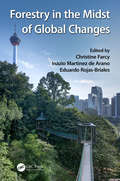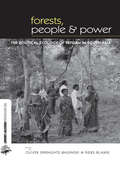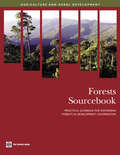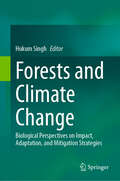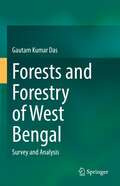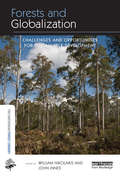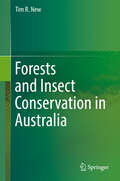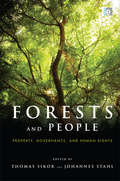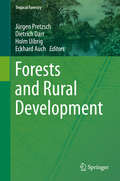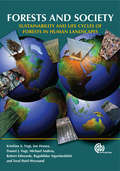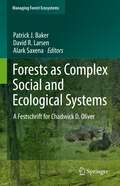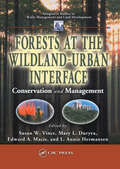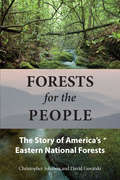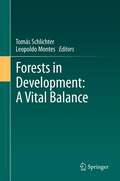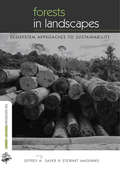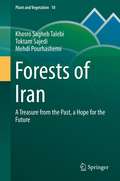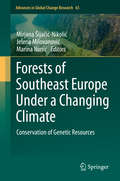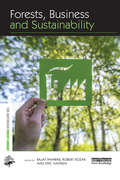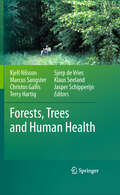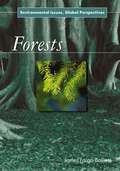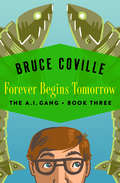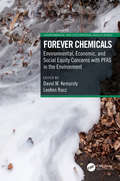- Table View
- List View
Forestry in a Global Context
by Roger Sands* Includes new chapters on climate change and international forest policy as well as expanded coverage of forest products and bioenergy production * International in coverage makes this book suitable for course use anywhere in the world as well as providing an international overview of the subject * Places world forestry in it's true social, environmental, historical and economic context
Forestry in the Midst of Global Changes
by Christine Farcy Eduardo Rojas-Briales Inazio Martinez de AranoForestry today, like many other sectors that traditionally rely on material goods, faces significant global drivers of societal change that are less often addressed than the environmental concerns commonly in the spotlight of scientific, political, and news media. There are three major interconnected issues that are challenging forestry at its foundation: urbanization, tertiarization, and globalization. These issues are at the core of this book. The urbanization of society, a process in development from the first steps of industrialization, is particularly significant today with the predominance and quick growth rate of the world’s urban population. Ongoing urbanization is creating new perspectives on forestry, inducing changes in its social representation, and changing lifestyles and practices with a tendency toward dematerialization. The process of urbanization is also creating a disconnect and in some ways is leaving behind rurality, the sector of society where forestry has traditionally developed and taken place over centuries. The second issue covered in this book is the tertiarization of the economy. In society today, the sector of services largely dominates the economy and occupies the major part of the world’s active population. This ongoing process modifies professional modalities and ways of life and opens new doors to forests through the immaterial goods they provide. It also profoundly changes the framework, rules, processes, means of production, exchanges between economic factors, and the processes of innovation. The third issue is undoubtedly globalization in its economic, political, and social components. Whether it’s through bridging distances, crossing borders, accelerating changes, standardizing practices, leveling hierarchical structures, or pushing for interdependence, globalization impacts everyone, everywhere in multiple ways. Forestry is no exception. Forestry in the Midst of Global Changes focuses on these global drivers of change from the perspective of their relationships with how society functions. By analyzing them in depth through multidisciplinary, interdisciplinary, and even transdisciplinary approaches, this book is helping to design the forestry of tomorrow.
Forests People and Power: The Political Ecology of Reform in South Asia (The Earthscan Forest Library)
by Piers Blaikie Oliver Springate-Baginski�With tens of millions of hectares and hundreds of millions of lives in the balance, the debate over who should control South Asia�s forests is of tremendous political significance. This book provides an insightful and thorough assessment of important forest management transitions currently underway.� MARK POFFENBERGER, EXECUTIVE DIRECTOR OF COMMUNITY FORESTRY INTERNATIONAL �The contributions in this volume not only breathe life into the fi eld of writing and analysis related to forests, they do so on the strength of extraordinarily insightful research. Kudos to Springate-Baginski and Blaikie for providing us with a set of thoroughly researched, provocative studies that should be required reading not only for those interested in community forestry in south Asia, but in resource governance anywhere.� ARUN AGRAWAL, ASSOCIATE PROFESSOR OF NATURAL RESOURCES & ENVIRONMENT, UNIVERSITY OF MICHIGAN, USA �Makes a significant contribution to theory and practice of participatory forest management.� YAM MALLA, EXECUTIVE DIRECTOR, REGIONAL COMMUNITY FORESTRY TRAINING CENTER FOR ASIA AND THE PACIFIC, BANGKOK �This excellent and timely book provides thought-provoking insights to the issues of power and politics in forestry and the difficulties of transforming age-old structures that circumscribe the access of the poor to forests and their resources; it challenges our assumptions of the benefits of participatory forest management and the role of forestry in poverty reduction. It should be of interest to policy-makers and to all those who have been involved with the struggle of transforming forestry over the decades.� DR MARY HOBLEY, HOBLEY SHIELDS ASSOCIATES (NATURAL RESOURCE MANAGEMENT AND PLANNING CONSULTANCY) �A rare combination of extensive field study, social science insights and policy studies � will be of immense value� DR N. C. SAXENA, MEMBER OF NATIONAL ADVISORY COUNCIL, GOVERNMENT OF INDIA In recent decades �participatory� approaches to forest management have been introduced around the world. This book assesses their implementation in the highly politicized environments of India and Nepal. The authors critically examine the policy, implementation processes and causal factors affecting livelihood impacts. Considering narratives and field practice, with data from over 60 study villages and over 1000 household interviews, the book demonstrates why particular field outcomes have occurred and why policy reform often proves so difficult. Research findings on which the book is based are already influencing policy in India and Nepal, and the research and analysis have great relevance to forestry management in a wide range of countries. Published with DFID.
Forests Sourcebook
by World BankThe 'Forests Sourcebook' provides practical operations-oriented guidance for forest sector engagement toward the goals of poverty reduction, conservation and economic development. Intended to guide World Bank lending activities and projects, the 'Forests Sourcebook' offers information useful to a broad audience of practitioners, government agencies, and non-governmental organizations. The 'Sourcebook was developed in partnership with members of the Collaborative Partnership on Forests, including the Food and Agriculture Organization. The 'Sourcebook' provides background on key issues, lessons learned, and recommendations for practitioners on a number of topics including private sector engagement, forest governance, sustainable plantation and commercial harvesting, and forest information management systems. Giving insight into the complex interplay between different realms of development work that effect or are affected by forests, the 'Forests Sourcebook' is a valuable tool for any stakeholder involved in development or business projects that could have impact on forests.
Forests and Climate Change: Biological Perspectives on Impact, Adaptation, and Mitigation Strategies
by Hukum SinghThis book comprehensively examines the complex relationship between forests and climate change from a biological perspective. It explores the effects of climate change, such as rising temperatures, greenhouse gas emissions, changing rainfall patterns, droughts, and cold spells, on individual trees and forest ecosystems. It considers how climate change affects forest structure, function, composition, and biodiversity, and the adaptive strategies forests employ to cope with changing conditions. The book focuses on understanding the adaptive capacity of forests and explores different mechanisms at stand and ecosystem levels that enable forests to respond to changing climatic conditions. It discusses how forests acclimate and adapt to new climates by modulating growth rates, morphology, phenology, physiology, biochemistry, and species composition. The role of genetic diversity and evolutionary processes in shaping forest resilience and adaptation is also explored. The book also explores potential mitigation strategies to reduce the impacts of climate change. Besides, this book discusses the ecological principles and the involvement of local communities in conservation and restoration efforts as alternative strategies to enhance the resilience of forest ecosystems against climate change. The book provides practical recommendations for policy makers, forest managers, and conservation practitioners to develop effective climate change adaptation and mitigation strategies in forest landscapes. This book serves as a valuable resource and a guide for researchers, students, and professionals in various fields to protect and sustainably manage vital ecosystems in a rapidly changing climate.
Forests and Forestry of West Bengal: Survey and Analysis
by Gautam Kumar DasThis book explains several basic concepts of forests and forestry research like social distancing of trees, solitary trees, green infrastructure of trees including typical forest stands like pocket forests, forgotten forests, community forests, and social forestry from one forest stand to another scattered in the districts of West Bengal. In the field of forest floors, depleting status of the forests stimulates to find out different models of afforestation programme like tree-island and rescue forest strategy through plantation programme. Huge loss of tree canopy ravaged by the series of cyclonic storms particularly in the districts of South Bengal seems to be recovered by bioeconomic model with the implementation of social forestry schemes. Thoughts of such models incited the author to go through statistical analysis on different matters and parameters of the forest stands. Determination of physico-chemical parameters of the forest soil are carried on hand in hand with the identification of Alfisol profile exposures in the forest floors. For finding out the present status of forests, district-wise review is worked out. Though scattered in the format of the forest patches, forest stands in the Jungle Mahal are remarkably interesting for any surveyor or tree-lover. Because of the reasons, surveys in the specific forest lands like Joypur and Beliatore of Bankura district and Garh Jangal and Aduria Forests under Bardhaman Forest Division are given special impetus for statistical measures, soil properties analysis, and identification of vegetation pattern. All these salient features inspire the author to take an attempt disseminating information and related characteristics of the forests and forestry of West Bengal. Researchers and students will get sufficient material from this book to enrich their knowledge on the forest environment and the author believes that this book will act as the pioneer work for the flourishment and amelioration of the forestry of West Bengal.
Forests and Globalization: Challenges and Opportunities for Sustainable Development (The Earthscan Forest Library)
by William Nikolakis John InnesThe overarching contribution of this book is a review and assessment of the current and future impacts of globalization on the world’s forests. The work has been developed by the "Resources for the Future" Task Force for the International Union of Forest Research Organizations (IUFRO). Four key themes are addressed: the effect of globalization on forests (including future trade flows); plantations as the primary source of forest products and its consequences, including plant breeding and forest health; the effect of new products such as bio-products and markets on forests; and the emergence of forest ecosystem services and their impact on the landscape and human communities. These four themes are examined in detail to map out the impacts of these trends for forests throughout the world and at multiple scales, and how forest research needs to be adapted to address these trends. Overall, the volume provides a major synthesis of current thinking and knowledge on the topic for advanced students, as well as policy-makers and professionals in the forest sector.
Forests and Insect Conservation in Australia
by Tim R. NewLosses of forests and their insect inhabitants are a major global conservation concern, spanning tropical and temperate forest regions throughout the world. This broad overview of Australian forest insect conservation draws on studies from many places to demonstrate the diversity and vulnerability of forest insects and how their conservation may be pursued through combinations of increased understanding, forest protection and silvicultural management in both natural and plantation forests. The relatively recent history of severe human disturbance to Australian forests ensures that reasonably natural forest patches remain and serve as ‘models’ for many forest categories. They are also refuges for many forest biota extirpated from the wider landscapes as forests are lost, and merit strenuous protection from further changes, and wider efforts to promote connectivity between otherwise isolated remnant patches. In parallel, the recent attention to improving forest insect conservation in harmony with insect pest management continues to benefit from perspectives generated from better-documented faunas elsewhere. Lessons from the northern hemisphere, in particular, have led to revelations of the ecological importance and vulnerability of many insect taxa in forests, together with clear evidence that ‘conservation can work’ in concert with wider forest uses. A brief outline of the variety of Australian tropical and temperate forests and woodlands, and of the multitude of endemic and, often, highly localised insects that depend on them highlights needs for conservation (both of single focal species and wider forest-dependent radiations and assemblages). The ways in which insects contribute to sustained ecological integrity of these complex ecosystems provide numerous opportunities for practical conservation.
Forests and People: Property, Governance, and Human Rights
by Johannes Stahl Thomas SikorA human rights-based agenda has received significant attention in writings on general development policy, but less so in forestry. Forests and People presents a comprehensive analysis of the rights-based agenda in forestry, connecting it with existing work on tenure reform, governance rights and cultural rights. As the editors note in their introduction, the attention to rights in forestry differs from 'rights-based approaches' in international development and other natural resource fields in three critical ways. First, redistribution is a central demand of activists in forestry but not in other fields. Many forest rights activists call for not only the redirection of forest benefits but also the redistribution of forest tenure to redress historical inequalities. Second, the rights agenda in forestry emerges from numerous grassroots initiatives, setting forest-related human rights apart from approaches that derive legitimacy from transnational human rights norms and are driven by international and national organizations. Third, forest rights activists attend to individual as well as peoples' collective rights whereas approaches in other fields tend to emphasize one or the other set of rights. Forests and People is a timely response to the challenges that remain for advocates as new trends and initiatives, such as market-based governance, REDD, and a rush to biofuels, can sometimes seem at odds with the gains from what has been a two decade expansion of forest peoples' rights. It explores the implications of these forces, and generates new insights on forest governance for scholars and provides strategic guidance for activists.
Forests and Rural Development
by Jürgen Pretzsch Dietrich Darr Holm Uibrig Eckhard AuchThis book provides an overview of the complex challenges and opportunities related to forest-based rural development in the tropics and subtropics. Applying a socio-ecological perspective, the book traces the changing paradigms of forestry in rural development throughout history, summarizes the major aspects of the rural development challenge in forest areas and documents innovative approaches in fields such as land utilization, technology and organizational development, rural advisory services, financing mechanisms, participative planning and forest governance. It brings together scholars and practitioners dealing with the topics from various theoretical and practical angles. Calling for an approach that carefully balances market forces with government intervention, the book shows that forests in rural areas have the potential to provide a solid foundation for a green global economy.
Forests and Society
by Robert Edmonds Toral Patel-Weynand Duncan Ray Kristina Vogt Jon Honea Daniel VogtThis book provides a broad-ranging textbook on the relationships between forests and society. It discusses the ways in which society can interact with forest landscapes without adversely affecting their sustainability. Topics covered include attitudes to, and uses of forests, the creation of today's forest landscapes, the impact of humans on forests, and forest sustainability and human health. The book also examines emerging issues in forestry such as possible solutions to balancing societies' needs with forest sustainability, managing forests in the urban-wildland interface, and the impact of illegal logging. It is packed with real-world case studies from the USA, Australia, Bolivia, Botswana, Canada, China, Iceland, India, Indonesia, Kenya, Mexico, Nepal, Peru, Philippines, Puerto Rico, and Thailand.
Forests as Complex Social and Ecological Systems: A Festschrift for Chadwick D. Oliver (Managing Forest Ecosystems #41)
by Patrick J. Baker David R. Larsen Alark SaxenaProfessor Chadwick Dearing Oliver has made major intellectual contributions to forest science and natural resources management. Over the course of his career he has actively sought to bring research and practice together through synthesis, outreach, and capacity-building. A common thread throughout his career has been complexity and how we as a society understand and manage complex systems. His work on forest stand dynamics, landscape management, and sustainability have all focused on the emergent properties of complex ecological and/or social systems. This volume celebrates a remarkable career through a diverse group of former students and colleagues who work on a wide range of subject areas related to the management of complex natural resource systems. Over the past decade there has been considerable discussion about forests as complex adaptive systems. Advances in remote sensing, social methods, and data collection and processing have enabled more detailed characterisations of complex natural systems across spatial and temporal scales than ever before. Making sense of these data, however, requires conceptual frameworks that are robust to the complexity of the systems and their inherent dynamics, particularly in the context of global change. This volume presents a collection of cutting-edge research on natural ecosystems and their dynamics through the lens of complex adaptive systems. It includes contributions by a wide range of authors from academia, NGOs, forest industry, and governmental organisations with diverse perspectives on forests and natural resources management. Each chapter offers new insights into how these systems can be made more resilient to ensure that they provide a diversity of ecological and social values well into the future. Together they provide a robust way of thinking about the many challenges that natural ecosystems face and how we as society may best address them.
Forests at the Wildland-Urban Interface: Conservation and Management (Integrative Studies in Water Management & Land Development)
by Mary L. Duryea Susan W. Vince Edward A. Macie L. Annie HermansenForests at the wildland-urban interface are at increasing risk due to the impacts of urbanization. Conserving and managing these forestlands for continued ecological and social benefits is a critical and complex challenge facing natural resource managers, land-use planners, and policymakers.Forests at the Wildland-Urban Interface: Conservat
Forests for the People: The Story of America's Eastern National Forests
by Christopher Johnson David GovatskiAt the turn of the twentieth century, widespread clearcutting resulted in ecological ruin and devastating fires in America's Eastern forests. A coalition of citizens, organizations, and business and political leaders fought against this pattern, and in 1911, they achieved a landmark victory with the Weeks Act, which protected millions of acres of Eastern forests. Forests for the People tells the fascinating story of this vital legislation and the citizens and organizations that made it a reality. While these protected forests survive today, many of the critical issues facing American forests in the twentieth century persist, and new threats have arisen--including oil shale drilling, invasive species, and development around national parks. In Forests for the People, Christopher Johnson and David Govatski draw upon the lessons and victories of the past to examine the vital issues facing American forests today and illuminate paths to better forest management.
Forests in Development: A Vital Balance
by Tomás Schlichter Leopoldo MontesForests in Development: A Vital Balance, shows some of the main advances in forestry over the six years spanning between the XII World Forestry Congress in Canada and the XIII WFC held in Buenos Aires. The book covers most of the themes of the XIII WFC, from biodiversity through production, policies, environmental services, and economic aspects, linked by sustainability. It provides a comprehensive view of forestry today, conveying its different aspects through one solid piece addressed by authors whose work denotes a concept of sustainable forest management which is not so much a puzzle laboriously put together as a many-faced unity, steered to achieve ultimately a better quality of living for present and future generations.
Forests in Landscapes: Ecosystem Approaches to Sustainability (The\earthscan Forest Library)
by Jeffrey Sayer�At last a really useful book telling us how all the rhetoric about ecosystem approaches and sustainable forest management is being translated into practical solutions on the ground� CLAUDE MARTIN, WWF INTERNATIONAL �For too long, foresters have seen forests as logs waiting to be turned into something useful. This book demonstrates that forests in fact have multiple values, and managing them as ecosystems will bring more benefits to a greater cross-section of the public� JEFFREY A. MCNEELY, CHIEF SCIENTIST, IUCN �This book demonstrates that [ecosystem approaches and sustainable forest management] are neither alternative methods of forest management nor are they simply complicated ways of saying the same thing. They are both emerging concepts for more integrated and holistic ways of managing forests within larger landscapes in ways that optimize benefits to all stakeholders� ACHIM STEINER AND IAN JOHNSON, FROM THE FOREWORD Recent innovations in Sustainable Forest Management and Ecosystem Approaches are resulting in forests increasingly being managed as part of the broader social-ecological systems in which they exist. Forests in Landscapes reviews changes that have occurred in forest management in recent decades. Case studies from Europe, Canada, the United States, Russia, Australia, the Congo and Central America provide a wealth of international examples of innovative practices. Cross-cutting chapters examine the political ecology and economics of forest management, and review the information needs and the use and misuse of criteria and indicators to achieve broad societal goals for forests. A concluding chapter draws out the key lessons of changes in forest management in recent decades and sets out some thoughts for the future. This book is a must-read for practitioners, researchers and policy makers concerned with forests and land use. It contains lessons for all those concerned with forests as sources of people's livelihoods and as part of rural landscapes. Published with IUCN and PROFOR
Forests in Revolutionary France
by Kieko MattesonThis book investigates the economic, strategic, and political importance of forests in early modern and modern Europe and shows how struggles over this vital natural resource both shaped and reflected the ideologies and outcomes of France's long revolutionary period. Until the mid-nineteenth century, wood was the principal fuel for cooking and heating and the primary material for manufacturing worldwide and comprised every imaginable element of industrial, domestic, military, and maritime activity. Forests also provided essential pasturage. These multifaceted values made forests the subject of ongoing battles for control between the crown, landowning elites, and peasantry, for whom liberty meant preserving their rights to woodland commons. Focusing on Franche-Comté, France's easternmost province, the book explores the fiercely contested development of state-centered conservation and management from 1669 to 1848. In emphasizing the environmental underpinnings of France's seismic sociopolitical upheavals, it appeals to readers interested in revolution, rural life, and common-pool-resource governance.
Forests of Iran
by Khosro Sagheb Talebi Toktam Sajedi Mehdi PourhashemiThe work describes the general ecological aspects of Iran as well as West and Central Asia in the introduction. The book includes three chapters, each describing the climate, geology and soil characteristics, vegetation and forest types, site demands of the main tree species and the ecogram of them, management and socio-economic issues of three different phytogeographical regions, mainly the Hyrcanian, Irano-Turanian, and Saharo-Sindian. Each chapter contains a table for introducing the English and Botanical names of the plant species mentioned in the chapter. The information presented in this book is based on personal experiences and results of research projects of the authors, as well as experiences of other forest scientists in Iran. The references are given at the end of each chapter separately. The book contains 10 tables, 37 black and white and 55 color pictures.
Forests of Southeast Europe Under a Changing Climate: Conservation of Genetic Resources (Advances in Global Change Research #65)
by Mirjana Šijačić-Nikolić Jelena Milovanović Marina NonićThis book integrates the different prospective, scientific and practical experience of researchers as well as beneficiaries and stakeholders in the field of forest conservation in Southeast Europe. The book stresses the importance of improving the adaptability of these ecosystems to the impacts of climate change. Gathered around a common idea, the book presents the latest results in forest genetic resources conservation at national and regional level. The chapters are written by experts from: Bosnia and Herzegovina, Bulgaria, Croatia, FYR Macedonia, Greece, Montenegro, Romania, Serbia and Slovenia. The book presents the current state, legal and institutional framework for conservation and management of forest genetic resources, case studies and best practices in the application of different conservation methods and techniques (in situ and ex situ) as well as climate change aspects in this area. This book will be of particular interest to scientists and experts in the field of forestry, environmental protection and rural development, bachelor, master and doctoral students, as well as for anyone interested in the conservation issues fuelled by ethical and economic motives.
Forests, Business and Sustainability (The Earthscan Forest Library)
by Eric Hansen Rajat Panwar Robert KozakForests are under tremendous pressure from human uses of all kinds, and one of the most significant threats to their sustainability comes from commercial interests. This book presents a comprehensive examination of the interactions between the forest products sector and the sustainability of forests. It captures the most current sustainability concerns within the forestry sector and various sustainability-oriented initiatives to address these. Experts from around the world analyze interconnected topics including market mechanisms, regulatory mechanisms, voluntary actions, and governance, and outline their effectiveness, potential, and limitations. By presenting a novel overview of the burgeoning field of business sustainability within the forestry sector, this book paves a way forward in understanding what is working, what is not working, and what could potentially work to ensure sustainable business practices within the forestry sector,
Forests, Trees and Human Health
by Kjell Nilsson Terry Hartig Marcus Sangster Klaus Seeland Sjerp De Vries Jasper Schipperijn Christos GallisThe link between modern lifestyles and increasing levels of chronic heart disease, obesity, stress and poor mental health is a concern across the world. The cost of dealing with these conditions places a large burden on national public health budgets so that policymakers are increasingly looking at prevention as a cost-effective alternative to medical treatment. Attention is turning towards interactions between the environment and lifestyles. Exploring the relationships between health, natural environments in general, and forests in particular, this groundbreaking book is the outcome of the European Union's COST Action E39 'Forests, Trees and Human Health and Wellbeing', and draws together work carried out over four years by scientists from 25 countries working in the fields of forestry, health, environment and social sciences. While the focus is primarily on health priorities defined within Europe, this volume explicitly draws also on research from North America.
Forests: Environmental Issues, Global Perspectives (Environmental Issues, Global Perspectives Ser.)
by James Fargo BalliettForests are considered the lungs of the planet, as they consume and store carbon dioxide and produce oxygen. These biomes, defined as ecological communities dominated by long-lived woody vegetation, historically have provided an economic foundation for growing nations, supplying wood for buildings, firewood for fuel, and land for expanding cities and farms. For centuries, industrial nations in Europe and the United States have relied on large tracts of forestland for economic prosperity. The research presented in this book reveals that population pressures are causing considerable environmental distress in even the most remote forest areas. Three detailed case studies are presented. The first provides an assessment of illegal logging deep in South America’s Amazon rain forest, a region closely tied to food and product demands thousands of miles away. The second examines the effect of increased hunting in Central Africa’s Congo forest, which threatens wildlife, especially mammal species with slower reproductive cycles. Finally the third describes encroachment on old-growth tropical forests on the Southern Pacific island of Borneo, which today is better managed thanks to the collective planning and conservation efforts of the governments of Brunei, Indonesia, and Malaysia.
Forever Begins Tomorrow (The A.I. Gang #3)
by Bruce CovilleCan the gang save the world before it's too late? When it comes down to adults versus kids, who's going to believe the kids--even if they are geniuses? That's the problem the A.I. Gang faces when they find themselves locked in a death-defying final showdown with the mysterious Black Glove. Contending with danger and disgrace, the team fights on with only the help of a mysterious friend to give them an occasional clue. But these six kids just can't give up. Would you, if you were the only thing standing in the way of a high-tech horror that could spell destruction for the entire planet? This ebook features an illustrated personal history of Bruce Coville including rare images from the author's collection.
Forever Chemicals: Environmental, Economic, and Social Equity Concerns with PFAS in the Environment (Environmental and Occupational Health Series)
by David M. Kempisty LeeAnn RaczForever Chemicals: Environmental, Economic, and Social Equity Concerns with PFAS in the Environment provides the reader with an understanding of the complex and interwoven issues associated with per- and polyfluorinated substances (PFAS) in our environment. The chapters provide in-depth perspective into various issues, including health, regulation, detection, clean-up strategies and technologies, and more. Taken together or as the reader’s interests lead them, the variety of topics covered in the book present a balanced perspective on this complex topic. It will address the current state of PFAS and where indicators are pointing for future developments. The book is also a deeper investigation of the regulatory challenges, analytical hurdles, and toxicological progress to date for the suite of PFAS chemicals. Features Explains the trends that will affect future policy and regulatory decisions Looks holistically at 4000+ PFAS chemicals Includes PFAS risk assessments at contaminated sites and biomonitoring insights Provides in-depth discussions on remediation technologies Illustrates quality and diversified content Provides a balanced perspective on this complex topic
Forever Young: A Life of Adventure in Air and Space
by John W YoungHe walked on the Moon. He flew six space missions in three different programs--more than any other human. He served with NASA for more than four decades. His peers called him the "astronaut's astronaut."Enthusiasts of space exploration have long waited for John Young to tell the story of his two Gemini flights, his two Apollo missions, the first-ever Space Shuttle flight, and the first Spacelab mission. Forever Young delivers all that and more: Young's personal journey from engineering graduate to fighter pilot, to test pilot, to astronaut, to high NASA official, to clear-headed predictor of the fate of Planet Earth.Young, with the assistance of internationally distinguished aerospace historian James Hansen, recounts the great episodes of his amazing flying career in fascinating detail and with wry humor. He portrays astronauts as ordinary human beings and NASA as an institution with the same ups and downs as other major bureaucracies. He frankly discusses the risks of space travel, including what went wrong with the Challenger and Columbia shuttles. Forever Young is one of the last memoirs produced by an early American astronaut. It is the first memoir written by a chief of the NASA astronaut corps. Young's experiences and candor make this book indispensable to everyone interested in the U.S. space program.

